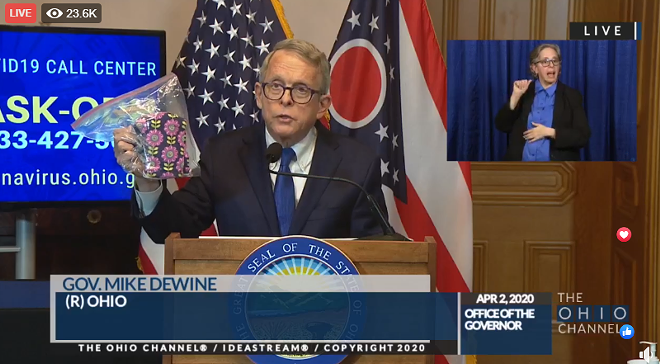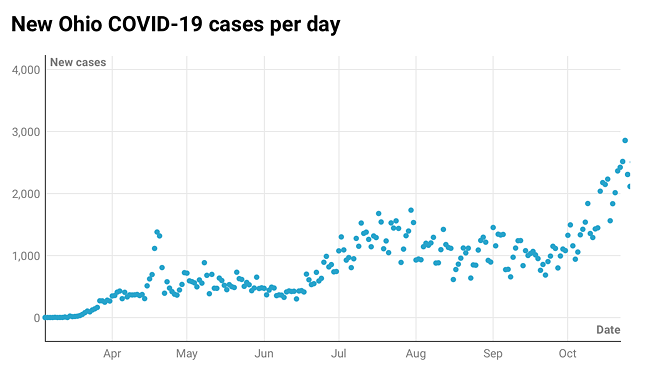A Harvard epidemiologist cast skepticism on Gov. Mike DeWine’s emphasis on forming “COVID defense teams” to respond to the pandemic on a county-by-county basis.
Dr. Michael Mina, an assistant professor of epidemiology at Harvard University’s T.H. Chan School of Public Health, said a “patchwork approach” of uneven policy applications is doomed to fail.
“As long as we’re doing this in a haphazard, individual district-by-district way, it simply will not work,” he said.
He said the virus pays no attention to political constructs like county lines, and that communities cannot control the virus with an “asynchronous” response — if community A drives case counts down, it’s only so long until community B’s more relaxed approach bleeds over.
On Thursday, DeWine said he was calling on county leaders in every community to form “COVID defense teams.” He said they’d comprise of mayors, commissioners, hospital executives, business leaders and more.
This comes as the epidemic in Ohio has soared to new heights — more Ohioans were infected with COVID-19 this week than any other during the pandemic. Similarly, more Ohioans are in the hospital Sunday with COVID-19 than any other point in history.
The county COVID-19 defense teams will focus on what resources are available in the community, where its problem lies, and what can be done to turn things around, DeWine said.
“Things happen at the local level,” he said. “Somebody at the local level who might not think they should wear a mask is a lot more likely to listen a neighbor than they are to me, or than they are to (Dr. Anthony Fauci, the federal government’s top infectious disease expert).”
Responding to Mina’s criticism, DeWine spokesman Dan Tierney said the teams are a supplement, not a replacement, to work the state is doing.
“We’re asking for more players in the field,” Tierney said.
DeWine said contact tracers and local health authorities are sounding alarms that they’re seeing spread at events like family gatherings, funerals, and weddings, more so than regulated spaces like bars and restaurants.
State policy, to be sure, drives much of Ohio’s COVID-19 response. The Ohio Department of Health, part of DeWine’s administration, has mandated masks, restricted alcohol sales on site at bars and restaurants, and implemented mass gathering and capacity restrictions on a statewide basis.
Significantly, however, it has left decisions on schools to local communities.
DeWine has repeatedly said there are no lockdowns or government responses of similar character looming, although he has said he wouldn’t rule them out entirely.
The ranking Democrat in the state House of Representatives, Emilia Sykes, criticized DeWine’s announcement Thursday.
“A county-by-county, city-by-city plan is no substitute for the statewide COVID response,” she said. “I understand delegation, but this is a dereliction of duty. This will not end well for Ohioans.”
Mina, speaking to reporters, warned the pandemic is moving in the wrong direction in the U.S.
The virus overcame “seasonal barriers” and continued to spread this summer. Now, colder weather is driving people inside, where the virus is more likely to spread. Plus, transmissibility increases as humidity decreases, all making for a deadly confluence.
“Unfortunately, we are, I think, in for a long winter,” he said.
Ohio and other states missed the chance to drive down case counts in June, July and August, he said, which could have set them up to confront the winter from a better position.
This, coupled with large scale rallies for President Donald Trump that continue to occur, could force states into uncomfortable positions if current trends continue.
“They’re going to be forced to shut down,” he said.
In Ohio, at least 219,000 residents have been infected with COVID-19. More than 19,000 have been hospitalized with the disease. More than 5,300 have died.
This story was originally published in the Ohio Capital Journal and republished here with permission.



